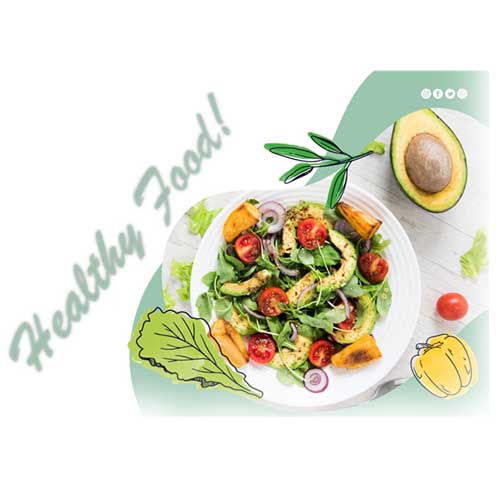Healthy Lifestyle
Maintaining a healthy lifestyle
Eating healthy food is a lifestyle decision. Add more fruits and vegetables in your diet and eat less carbohydrates, high sodium and unhealthy fat.
Avoid eating junk food and sweets. Avoid skipping a meal—this will only make your body crave more food the moment you resume eating.


Squatty Potty …..You were born to squat!
The Squatty Potty puts your body into a natural squat on the toilet, fully loosening the muscle to give you the bowel movement your body was designed for. The Squatty Potty is uniquely designed to give you the best bathroom experience, the way nature intended.
Easily accessible when you need it and out of the way when you don’t.
Organic Gold Flax Oil
Foods Alive’s Organic Gold Flax Oil is full of omega-3 fatty acids and nutrient-rich lignans. We believe that the freshest and best-tasting flaxseed grows in the most nutrient-dense and mineral-rich soil.
Before we decide which seed to use, we artisan cold-press samples from several certified organic farmers. Then we taste each batch to find the one with the lightest and nuttiest taste, showing its full potential of essential minerals and nutrients. This is why our Organic Golden Flax Oil has an amazingly great taste that is oh so delicioso!
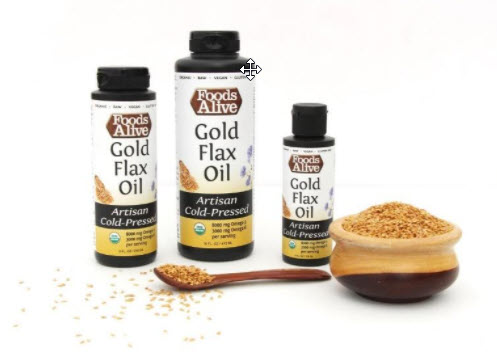

Organic Chia Seeds
For centuries, Native Indian Peoples in the Americas have used chia seed as a staple food. Aztec warriors subsisted on chia seeds during battles and hunting expeditions. Indians of the Southwest would eat as little as a teaspoon of chia seeds during a 24-hour march. Indians ran from the Colorado River to the Pacific Ocean to trade turquoise for shells, carrying only a pouch of chia seed for nourishment.
There are two colors of chia seeds, white and black. Some claim that the white seeds are more potent but this is not the case. Both types contain essentially the same amount of omega-3, protein, fiber, etc.
- Benefits (link) One ounce of Chia seed contains as much omega-3 as 8-ounces of salmon, as much calcium as a cup of milk, as much fiber as 1/3 cup of bran, as much iron as 1/3 cup of spinach leaves, as much vitamin C as 2 oranges, and as much potassium as half a banana.
- COMPLETE PROTEIN SOURCE: Chia seed is a complete source of dietary protein providing all the essential amino acids. Compared to other seeds and grains, chia seed provides the highest source of protein: between 19 to 23 percent protein by weight.
- ABSORB AND RETAIN WATER: One of the exceptional qualities unique to the chia seed is its ability to absorb more than 12 times its weight in water. This ability to hold water can prolong hydration and retain electrolytes in body fluids, especially during exertion. Normal fluid retention ensures normal electrolyte dispersion across cell membranes, maintains fluid balances, and aids normal cellular function.
- GEL-FORMING PROPERTY: Chia seeds contain a mucilloid gel which protects the seed against drying in arid climates where the plants grow. When a spoonful of chia seed is mixed in a glass of water and left for 30 minutes, almost a solid gelatin will form. This gel-forming reaction is due to the soluble fiber in the chia seeds. Researchers believe this same gel-forming phenomenon occurs in the stomach when foods containing these gummy fibers, know as mucilages, are eaten. The gel formed when chia seeds are eaten creates a physical barrier between carbohydrates and digestive enzymes that break them down, thus slowing the conversion of carbohydrates into sugar and extending endurance.
- BLOOD SUGAR REGULATOR: The gel forming property of chia seed tends to slow digestion and sustain balanced blood sugar levels, which can be helpful in preventing or controlling diabetes. Today, there is an incidence of diabetes among some Native American tribes of approximately 47%. Clinical studies show that when the Native Americans refrain from eating the “white man’s diet” and return to their indigenous food (including chia seeds), they can control and even eliminate diabetes.
- EASY TO DIGEST: The water absorption, bulking-agent property of chia seed is an important aid to human digestion. Whole, water-soaked chia seeds can be easily digested and absorbed. This results in rapid transport of chia nutrients to the tissue for use by the cells. This efficient assimilation makes chia seeds very effective when rapid development of tissue takes place, especially during growth periods of children and adolescents. Chia also facilitates the growth and regeneration of tissue during pregnancy and lactation, and aids regeneration of muscles for conditioning athletes and bodybuilders.
- ESSENTIAL UNSATURATED OIL: Chia seed contains three to ten times the oil concentrations of most grains. The unsaturated fatty acids in chia seed are essential oils the body needs to help emulsify and absorb the fat-soluble vitamins A, D, E, and K. Chia seeds are rich in the essential unsaturated fatty acid, linoleic, which the body cannot manufacture for respiration of vital organs, making it easier for blood to transport oxygen, help to regulate blood coagulation, are essential for normal glandular activity, and nourish skin cells, mucus membranes and nerves. Chia seeds contain beneficial long-chain triglycerides (LCT) in the right proportion to reduce cholesterol on arterial walls.
- MINERAL RICH: Chia seed is a rich source of calcium and also contains boron, which acts a catalyst for the body to absorb and utilize the available calcium.

Organic Sunflower Seeds
No matter how you decide to enjoy our delicious sunflower seeds, your body is sure to thank you for providing it with needed essential vitamins and minerals. Sunflower seeds are a tasty and crunchy treat that you can enjoy raw or roasted and salted.
Nutritional Yeast
Most Nutritional Yeast products are fortified with synthetic B-vitamins, but not this one!
Non-Fortified Nutritional yeast provides the great cheesy flavor you’re looking for without the use of synthetic additives. With a nutty cheesy flavor, our unfortified nutritional yeast is a favorite among many vegans because of its unique flavor and similarity to cheese when added to foods.


Organic Maca Powder
The maca plant (lepidium meyenii) is a mat-like perennial that grows between 13,000 and 14,500 feet above sea level in the high Andean plateaus of Peru. Its tuberous roots resemble those of its relative― the radish. Organic maca pudding and jam are popular among Andes natives.
Although unrelated to ginseng, organic maca is often referred to as Peruvian ginseng because of its similar properties. To Andean Incas, organic maca, a sweet and somewhat nutty-tasting dried root, is considered a delicacy. Organic maca boiled in water makes a drink sweeter than cocoa.
The delightfully fragrant powder is rich in calcium, magnesium, phosphorous and iron, and contains trace minerals, including zinc, iodine, copper, selenium, bismuth, manganese, and silica, as well as B vitamins.
Traditionally, native medicine practitioners and herbalists have recommended maca for stimulating and regulating the endocrine system.
Organic Cacao Powder and Organic Cacao Nibs
Cacao beans are the source of all chocolate, cacao nibs, cacao powder, and cacao butter. Cacao beans were so highly cherished by the Aztecs and Mayans that they were often used as currency and in religious ceremonies.
Our cacao powder comes from cacao beans that are grown on the island of the Dominican Republic under a dense forest canopy basking in the shade of tropical fruit trees and the Caribbean sun. They are grown in nutrient-rich island soil, which gives it a unique flavor profile that is unlike any other. Each pod of cacao beans is hand-picked and selected only when ripe and mature, providing you with the best possible flavor and nutritional value.
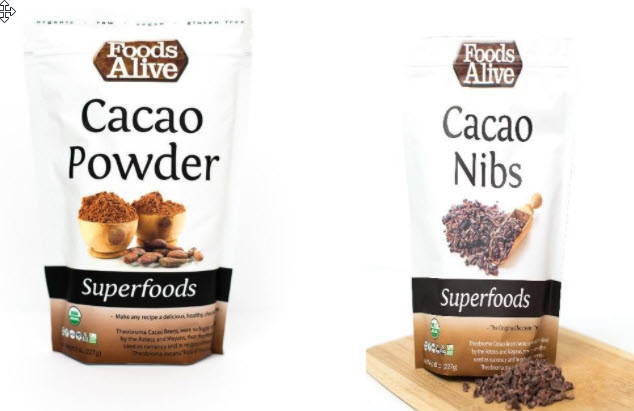

ORGANIC RAW CHOCOLATE:
HISTORY, BENEFITS & CHOCOLATE MAKING PROCESS
According to some historians, the evidence of cacao consumption dates back three to four millennia and there are some traces of cacao in artifacts dating back as far as 1400 B.C.E. As we can see, the Cacao Bean has been in use forever in the tropical regions of the planet. It wasn’t until Spanish explorer, Hernando Cortez, was welcomed by the Aztec leader, Montezuma, as a reincarnated deity and given a chocolate drink (the Aztecs called it ‘xocoatl’) in celebration of his arrival. The drink was considered bitter by many at first, until they added honey or cane sugar. After this sweet addition, it became very popular in Spain.
Cacao powder is created by cold-pressing raw, organic cacao beans into a pressed cake separating the oil from the protein and fiber. A high-accuracy thermometer monitors the process, so that the temperature is never allowed to exceed 120° F and is usually 104° F. All other cocoa powders are exposed to temperatures as high as 300° F! The remaining dry cake-like material is then cold-ground and fine-milled so that only the finest, most bio-available raw cacao particles become the finished product. This allows for maximum digestion and antioxidant absorption.
Cacao is incredibly rich in magnesium and is most likely the number one source for this essential mineral. Other essential minerals present in cacao are calcium, zinc, iron, copper, sulfur, magnesium, and potassium. The cacao bean also contains more antioxidant flavanoids than any other food tested including blueberries, red wine, and green tea. In fact, studies have shown cacao to have over twice as many antioxidants as red wine and three times as much as green tea.
Raw cacao contains many chemicals that enhance physical and mental well-being including alkaloids, proteins, magnesium, beta-carotene, leucine, linoleic acid, lipase, lysine. It also contains some neurotransmitters such as dopamine and anandamide which is the so-called bliss chemical associated with the feeling of being in love. Raw cacao also contains theobromine which is similar in effect to caffeine.
The Latin name of the cacao tree is Theobroma Cacao, which is translated as “Food of the Gods.” Cacao Beans were highly valued and used as currency amongst the Aztecs & Mayans. According to a 16th-century Aztec document, one could purchase a tamale for 1 bean and a decent sized hen for 100 beans. Another reason these little guys were treasured so much was because many of the Aztecs and Mayans believed the cacao bean had divine properties, which could be used in sacred rituals for birth, marriage, and death.
In the 17th Century, after Cortez brought cacao back to Spain, it became very popular to drink this with sugar. This delicacy was mainly a privilege of the rich, until the steam engine came along in the 1700s and made mass production more prevalent. As a result of the availability, this allowed more people to experiment with this superfood.
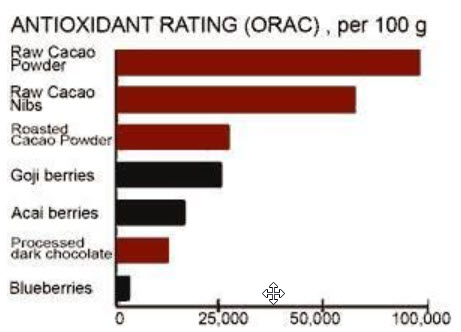
In 1828, a Dutch chemist discovered a way to make powdered chocolate. He did this by separating about half of the natural fat (cacao butter) from the chocolate liquor and then grinding what was left and combining it with alkaline salts to curb the bitter taste. This gentleman’s product became known as “Dutch Cocoa.” However, the credit for making the first chocolate bar is given to Joseph Fry, who discovered that one could make a moldable chocolate paste by adding the melted cacao butter back into the “Dutch Cocoa.” By 1868, Cadbury jumped on board and began to market boxes of chocolate candies in England. Within a few years, milk chocolate hit the market by another heavyweight: Nestle.
Today, there are many smaller, artisan type chocolatiers that are leading the charge to make chocolate with less fillers and chemicals, and only using pristine ingredients— the fewer the better. Foods Alive is proud to be one of these in the long history of chocolate artisans by offering our Raw Organic Chocolate, made with only 3 Certified Organic ingredients: Cacao Beans, Coconut Sugar, and Cacao Butter.
BENEFITS
Recent scientific studies now show that chocolate may be good for you when used in moderation (information that usually gets passed up when reading about the benefits of chocolate). Studies show that the correct amount of chocolate to be eaten that will provide the best health benefits is 6.7 grams per day— or one small square of chocolate two or three times a week. However, other studies have shown that enjoying 1.5 ounces of dark chocolate a day for 2 weeks, reduced stress hormone levels. So as you can see, the amount needed is still indeed a small amount to receive the benefits of chocolate.
One benefit of eating chocolate (in moderation) is that they have antioxidant polyphenols, whose properties include neutralizing free radicals. These can potentially help slow down the development of diseases such as Alzheimer’s, heart disease, or cancer. Chocolate also contains anandamide (Sanskrit word for “bliss”), which is a neurotransmitter in the brain that temporarily blocks the feelings of pain and anxiety. The theobromine in chocolate has been shown to produce higher levels of physical energy and mental alertness while somehow also lowering blood pressure in women.
CHOCOLATE MAKING PROCES

HARVEST
Foods Alive receives their Rainforest Alliance Certified Cacao Beans from Ecuador. But before they come in, they are harvested from pods on the cacao tree. Harvesting cacao pods is done by hand because the harvester needs to cut the pod from the tree, making sure not to damage the surrounding flowering buds, immature pods, or the stem area from which the bud grows. Once this is complete, the pods are carefully broken to release the gold— the cacao beans. The beans and pulp are scooped out right away and piled onto a mat made of banana leaves. Then they are covered or put into a bin or a box with a lid. At this point the fermentation process takes place.
FERMENTATION
Fermentation occurs when the pulp surrounding the cacao bean is converted into alcohol by the yeasts present in the air and the heat that is produced while being covered. While everything is fermenting, the beans are gently mixed around to allow oxygen into the pile so that the alcohol will turn into lactic and acetic acid. The remaining liquid, including the alcohol, slowly leaks out of the pile or through tiny slits in the cover until all that is left are the cacao beans. Germination in the cacao bean is stopped by the 120 °F temperatures during the fermentation process and the beans themselves, plump up from gathering the moisture from their environment. The fermentation process can take up to eight days, depending on the species of cacao bean that is chosen.
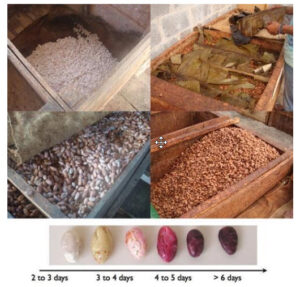
DRYING & STORAGE
Since the cacao bean is now high in moisture, it must be dried before it is stored or makes it to its destination. There are a couple of ways to dry cacao beans, depending on the climate or size of the plantation. One way is by sun-drying it, which usually happens on smaller plantations that are located in drier regions. In areas where there is daily rainfall, the beans are usually dried in sheds, as long as there is enough air circulating around the flats of beans. The use of fire to speed up the drying process of the cacao bean is highly frowned upon by most chocolatiers because it leaves a smoky taste. Once the percentage of moisture in the cacao bean arrives at 6 to 7 percent, they are sorted and then bagged. The sorting process is pretty important because most cacao beans on the market are sold based on their size and quality. Once this process is complete the cacao beans are loaded onto ships and trucks and then delivered to chocolate manufacturers.

CHOCOLATE MAKING PROCESS
Once the beans are received for Foods Alive, they go through a winnower, where the shell is removed and we are left with the nibs. The nibs are then put into a mill, where they are broken down even more. During the winnowing and milling process, the temperature reaches around 80 °F. Then once the ingredients (Organic Coconut Sugar & Organic Cacao Butter) are added, they are blended in a mixer (around 80°F). After the blending process, it’s then placed in a mill (around 105 °-110°F) where the mixture is crushed until it turns from a pasty mix into a smooth rich chocolate. Then the chocolate is placed in a tempering unit. The tempering process raises the temperature of the chocolate to 113°F, then lowers it to 82°F and then raises it again to 87°F. This allows the chocolate to keep a solid state instead of it being soft. Once this is finished, the chocolate is ready to go through a depositor to provide tasty drops of Organic Raw Chocolate and then they are packaged into bags with love.


